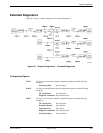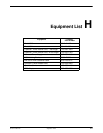
COMSPHERE 3900 Series Modems
Glossary-4 September 1998 3910-A2-GN32-40
A process that transfers device firmware and software from a locally-attached PC to a device, or
allows the duplication of firmware and software from a local device to a remote device.
A device that is connected farther from the host computer.
Data Terminal Equipment. The equipment, such as a computer or terminal, that provides data in
the form of digital signals for transmission.
A temporary work area used to view and change configuration options from the DCP without
impacting modem operation. The edit area can be loaded from one of five configuration option
areas: Active (Operating), Active (Saved), Customer 1, Customer 2, or Factory.
Electronic Industries Association. This organization provides standards for the data
communications industry to ensure uniformity of interface between DTEs and DCEs.
An Electronic Industries Association standard defining the 25-position interface between data
terminal equipment and data communications equipment.
An algorithm used to detect and correct data transmission errors.
Default setting is +++. This sequence lets you switch your modem from Data mode to Command
mode.
The extension of a circuit where the tributary DCE is connected to a downstream (extended)
control DCE.
An asynchronous message (in either numbers or words) that includes VF data rate and error
control information that the modem sends to the DTE after executing or trying to execute a
command.
Retraining at a lower rate or speed.
Federal Communications Commission. The Board of Commissioners that regulates all electrical
communications that originate in the United States.
Forward Error Correction. A method of error control for data transmission where the receiving
device can detect and correct a character or block of code containing a predetermined number
of erroneous bits.
Front-End Processor. A communications computer associated with a host computer that
manages the lines and routing of data through the network.
The capability to transmit in two directions simultaneously.
One of three keys on the DCP that allows you to select or scroll to an LCD entry. Function keys
are labeled F1, F2, and F3.
The capability to transmit in two directions, but not simultaneously.
The exchange of predetermined codes and signals (tones) to establish a connection between
two modems. During handshaking the modems determine the modulation, rate, and type of error
control they will use.
High-Level Data Link Control. A communications protocol defined by the International Standards
Organization (ISO).
A symbol appearing in the upper right-hand corner of the LCD, indicating that more selections
are available than what appears on the LCD.
A computer attached to a network that shares its information and devices with the rest of the
network.
Hertz. A unit of frequency that equals one cycle per second.
A state in which the modem’s configuration options can be modified or commands can be issued
to the modem using AT commands.
download
downstream device
DTE
edit area
EIA
EIA RS-232
error control
escape sequence
extended network
extended result codes
fallback
FCC
FEC
FEP
full-duplex
function key
half duplex
handshaking
HDLC
hidden choice
indicator
host
Hz
idle state


















